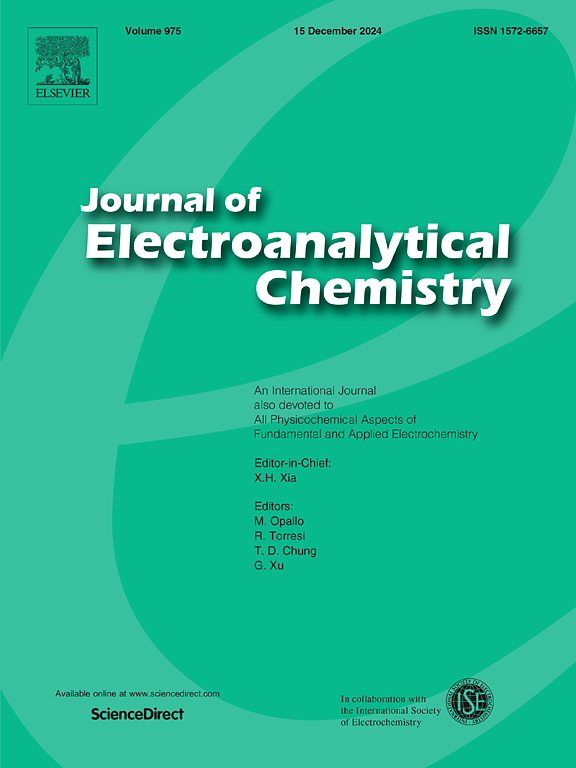Anchoring enhancement of Graphdiyne by doping and molecular intercalation for Lithium−sulfur batteries
IF 4.1
3区 化学
Q1 CHEMISTRY, ANALYTICAL
引用次数: 0
Abstract
Lithium−sulfur (Li − S) batteries are the most promising next-generation energy storage devices due to the high energy density, low cost, and environmental friendliness. The shuttle effect of lithium polysulfides (LiPSs) have hindered the commercialization of Li − S batteries owing to the remarkable deteriorations to the Coulombic efficiency, capacity retention and cycle life. Herein, we propose a method of B element doping combining with methylbenzene molecular intercalation to modify graphdiyne (GDY) as the cathode of Li − S batteries, which strengthens the anchoring to LiPSs. First-principle calculations are performed to explore the adsorption configurations, energies, charge transfers and diffusion coefficients of S8 and LiPSs. Pure GDY can only adsorbed S8 and LiPSs weakly, resulting in the LiPSs can freely diffuse and dissolve into the electrolyte and then self-discharge. Then, GDY with B element doping (B@GDY), facilitates the charge exchange between adsorbates and substrate by enabling S gaining extra electrons from B elements, which further enhances the absorption energies. The molecular intercalation to B@GDY (B_Ben@GDY) induce a steric hindrance to restrict the diffusion of S8 and larger LiPSs, making the anchoring effect significantly enhanced. Last, the comparison between adsorption energies and the binding energy between LiPSs and solvent molecules, further supports the anchoring effects of B@GDY and B_Ben@GDY to LiPSs. Our study serves as a guide for the design of the cathode free from the shuttle effect for Li − S batteries.

通过掺杂和分子插层提高锂硫电池中石墨二炔的锚定性能
锂硫电池(Li -硫电池)具有高能量密度、低成本、环保等优点,是最有前途的下一代储能设备。多硫化锂(LiPSs)的穿梭效应使锂离子电池的库仑效率、容量保持率和循环寿命显著下降,阻碍了锂离子电池的商业化。为此,我们提出了一种B元素掺杂结合甲基苯分子插层的方法来修饰石墨烯(GDY)作为锂离子电池的阴极,增强了对LiPSs的锚定。通过第一性原理计算,探讨了S8和LiPSs的吸附构型、能量、电荷转移和扩散系数。纯GDY对S8和LiPSs的吸附较弱,导致LiPSs可以自由扩散溶解到电解液中自放电。然后,掺杂B元素的GDY (B@GDY)通过使S从B元素中获得额外的电子,促进了吸附物与底物之间的电荷交换,从而进一步提高了吸收能。分子嵌入B@GDY (B_Ben@GDY)后会产生位阻,限制S8和较大的LiPSs的扩散,使锚定效果显著增强。最后,通过对LiPSs与溶剂分子的吸附能和结合能的比较,进一步支持B@GDY和B_Ben@GDY对LiPSs的锚定作用。本研究对锂硫电池无穿梭效应阴极的设计具有指导意义。
本文章由计算机程序翻译,如有差异,请以英文原文为准。
求助全文
约1分钟内获得全文
求助全文
来源期刊
CiteScore
7.80
自引率
6.70%
发文量
912
审稿时长
2.4 months
期刊介绍:
The Journal of Electroanalytical Chemistry is the foremost international journal devoted to the interdisciplinary subject of electrochemistry in all its aspects, theoretical as well as applied.
Electrochemistry is a wide ranging area that is in a state of continuous evolution. Rather than compiling a long list of topics covered by the Journal, the editors would like to draw particular attention to the key issues of novelty, topicality and quality. Papers should present new and interesting electrochemical science in a way that is accessible to the reader. The presentation and discussion should be at a level that is consistent with the international status of the Journal. Reports describing the application of well-established techniques to problems that are essentially technical will not be accepted. Similarly, papers that report observations but fail to provide adequate interpretation will be rejected by the Editors. Papers dealing with technical electrochemistry should be submitted to other specialist journals unless the authors can show that their work provides substantially new insights into electrochemical processes.

 求助内容:
求助内容: 应助结果提醒方式:
应助结果提醒方式:


